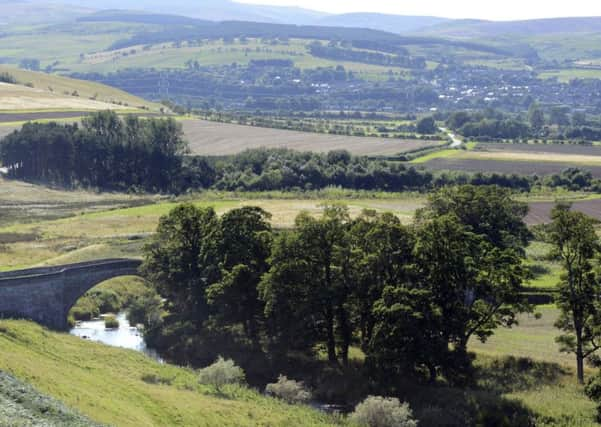Glendale, History Society


After meeting at The Biscuit Factory for a tasty lunch, members of Glendale Local History Society reported to the Victoria Tunnel office.
Our guides gave an introduction and safety briefing before a short tour of the Ouseburn Valley, which used to be a hive of industrial activity.
Advertisement
Hide AdAdvertisement
Hide AdWhere the Ouseburn Café stands used to be a lead works. The Cluny music venue was once a distillery making Cluny Whisky, and the iron bars on ground floor windows overlooking the burn were fitted to stop workers passing cases of whisky to their friends in boats floated up on the high tide. The Toffee Factory, now home to digital and creative offices and studios, was previously a cattle sanatorium, where the health of imported cattle was checked, then a store warehouse, and later the Maynards toffee factory.
We eventually arrived at the entrance to the Victoria Tunnel where we were issued with hard hats and torches. The tunnel is just 6ft 3ins high and 7ins wide so taller visitors were encouraged to carry a chair to avoid aching shoulders during the many stops.
The guides explained that we would walk up the tunnel in the 1940s and return in the 1800s.
We stopped to hear how during the Second World War the tunnel was used as an air-raid shelter by up to 2,000 people at a time. It had cost more than £37,000 to adapt the tunnel for use as a shelter, including the addition of concrete blast walls to stop potential bomb debris flying inside.
Advertisement
Hide AdAdvertisement
Hide AdThere were basic bunk beds for those working for the war effort, pregnant women and first aid workers, and some benches for the lucky ones to sit on. The rest had to sit on the floor, which, despite efforts to clean it up, is still covered in coal dust. The toilet facilities were very basic. Chemical toilets were located near the entrances, just six each for ladies and gents.
Those sheltering were there for up to nine hours at a time, having to wait until the German planes that had flown over en-route to bombing raids in Belfast, Glasgow and Liverpool had passed over again on their way home. Any bombs left over from the raids tended to be jettisoned over Tyneside.
After about an hour we reached a line of sandbags marking the end of the part of the tunnel which is open to the public and turned round and travelled back in time to the opening of the new Leazes Main, or Spital Tongues, colliery.
Our second guide took over and explained that a surface wagonway, proposed by the engineer William Gillespie to replace the costly transport of coal to the Tyne by horse and cart, had been turned down by the city council because it would cause great inconvenience and danger to the inhabitants of the town and, more importantly, compromise the Freemen’s right to grazing on the Town Moor.
Advertisement
Hide AdAdvertisement
Hide AdGillespie then proposed an underground wagonway, running below the Town Moor, Barras Bridge and Shieldfield 2.25 miles to the Tyne, near the mouth of the Ouseburn.
The loaded wagons would roll along a single standard-gauge railway track to the river, down the gentle gradient of the tunnel. A long rope connecting the wagons to a stationary 40hp steam engine at the Spital Tongues site would control the speed of descent and winch the empty wagons back up to the pit head.
Permission was granted in June 1838 and work began 12 months later. The tunnel was finished on January 8, 1842, and was shown to reduce the cost of transporting coal to the river by 90 per cent.
Construction of the tunnel was remarkably free of mishaps, not so the operations. In 1843 the haulage rope broke and the wagons careered down the track and into the river, injuring one man. In 1843 the haulage engine’s boiler exploded, killing the fireman. Nine years later it exploded again, this time killing both the engineer and the fireman.
Advertisement
Hide AdAdvertisement
Hide AdThe most serious accident happened in 1952 when the colliery was up for sale. Two potential buyers, brothers Ralph and Benjamin Arkless, were viewing the tunnel accompanied by a staithman. A message had been sent to the colliery to request that no wagons be sent down as they almost filled the space between the walls and there were no refuges.
However, the message failed to reach the colliery. At the top of the tunnel, two men assigned to clear debris had just filled a hand-operated wagon and climbed aboard to take the load down to the river. Tragically, as the wagon began to move the brake-man slipped and fell off, and the wagon went rumbling out of control towards the inspection party, who were half way along the tunnel.
We were played a recording that simulated the sound of the wagon coming down the tunnel towards us. In the darkness the initial faint rumbling steadily increased until it became a deafening roar. We knew there was nothing coming, but even so it was terrifying.
The men in the tunnel must soon have grasped what was happening and at the same time realised that they had no means of escape. Ralph Arkless threw himself down between the rails and survived uninjured, his brother pressed himself against the wall and was badly injured, but survived. The staithman William Coulson tried to out-run the wagon and was killed. Subsequently, the colliery underviewer George Fletcher was charged with negligence.
Advertisement
Hide AdAdvertisement
Hide AdHaving taken two-and-a-half years to build, operations in the tunnel ceased less than 20 years after it had opened owing to financial difficulties.
Everyone agreed it had been a most interesting visit and an enjoyable day out in the Ouseburn Valley.